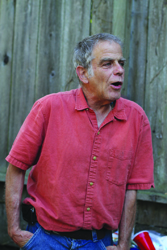A Life in Verse
Wedding his Penchant for Verse and Translation, John Oliver Simon ’64 Brings Poetry to the Public Schools

John Simon ’64 summarizes his enduring poetic pursuits, “I have remained true to my calling.” Photo by Kia Simon
Poet John Oliver Simon ’64 discovered a happy alternative to his original plan to be an English professor when, seven years after leaving Swarthmore, he joined California Poets in the Schools, a large writers-in-residence program for elementary through high-school students.
Now, more than 40 years after making that shift, Simon has been recognized with a major award for his pedagogical achievement: He was named 2013 Teacher of the Year by River of Words (ROW), an international network co-founded by poet laureate Robert Hass that promotes environmental literacy by teaching the art and poetry of place to young people.
Simon currently serves as artistic director of Poetry Inside Out (PIO), a program of the nonprofit Center for the Art of Translation in San Francisco. Last year, six PIO pupils, including Abdul Tawil, 12, a student of Simon’s, were finalists in an ROW contest that attracted more than 10,000 poems from K–12 students.
Simon describes the PIO teaching process: “Our instructors bring great poems in a wide variety of original languages into a dozen mostly lower-income elementary and middle schools in the Bay Area. We coach students to translate Pablo Neruda from Spanish, Dante Alighieri from Italian, Li Bai from Chinese and Nazim Hikmet from Turkish.” Tawil’s poem was translated from Latvian.
Simon has long maintained that “teaching poetry to kids enabled me to make [poetry] public and be of service.”
His connection to poetry runs long and deep. “I decided that I was a poet when I was 15,” he declares. Arriving at Swarthmore from the progressive Putney School in Vermont, Simon studied with English professor and future United States poet laureate Daniel Hoffman, attended hootenannies, cultivated lifelong friends, and achieved highest honors in English. Moving to the University of California–Berkeley for graduate school “was like coming home,” he recalls, since his mother’s family had lived in the area for generations.
Simon says that while “the ’60’s kind of derailed” his early professional aspirations to become an English professor, his poetic impulse remained undimmed. After leaving grad school, he traveled in Europe, edited the poetry journal Aldebaran Review (recently resurrected online), and practiced his craft, focusing on the California landscape and thinking of himself as “a poet of place.”
Simon’s poetic imagination expanded enormously in the early 1980s when, inspired by the strong Latino culture of California, he began to learn Spanish. Visits to Mexico City coupled with subsequent formal study reinforced the poet’s love of the language.
“Reading in Spanish, conversing in Spanish all the time is heaven,” he says. This immersion, intensified through travel, poetry festivals, and personal friendships, resulted in his translations of hundreds of contemporary Latin-American poems into English. Some of his own works, which tend to be autobiographical, have also been translated into Spanish.
In the mid-1990s after a nearly yearlong trip throughout Latin America, Simon wrote and illustrated a book of 131 eight-line stanzas called Caminante, which Pulitzer Prize-winner Gary Snyder praised as “a major poem.” The following stanza, written in Chile, exemplifies Simon’s evocative imagery:
CUCAO
This is where they run out of road.
Where the bridge sways with the weight of your breath.
Where the tracks of all your friends are blurred by blowing sand.
To the edge of earth, where water howls and prays,
Where seagulls peck at a woven robe of flesh,
Where the sun is squeezed to a glowing syllable
And gone, and then, as if to balance things,
The moon’s pale cup is lifted from a final line of hills.
Since 2001, Simon has demonstrated his passion for translation, poetry, and public service through his job as PIO’s artistic director. Aided by glossaries and other support, paid teachers coach students to translate poems from more than two dozen original languages, including Japanese, Turkish, Hebrew, French, German, Arabic, or Chinese.
Unlike multiple-choice exams with one correct answer, the act of translating reveals to the students that there are “a lot of interesting plausible approaches, which is more like life,” Simon explains. Students, who learn not only about grammar and vocabulary but also about poetic concepts such as rhythm and imagery are inspired to create their own poems.
Simon’s current poems often focus on his beloved young granddaughter and have returned to the stricter sense of form demonstrated by his early teacher Hoffman. Sonnets with 11-syllable lines, borrowed from Spanish, allow more metrical freedom, while Simon’s subjects and tone of voice are more like his later poetic model, Gary Snyder.
“They’re like two angels of my nature, one on each shoulder: East Coast formal and West Coast Zen-like hippie.”
 Email This Page
Email This Page